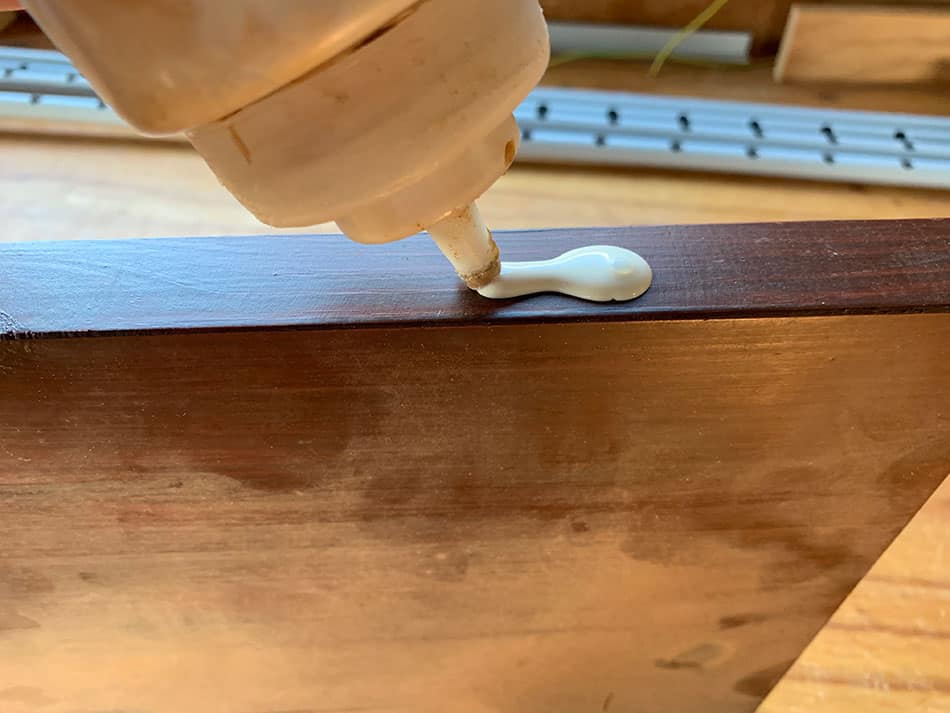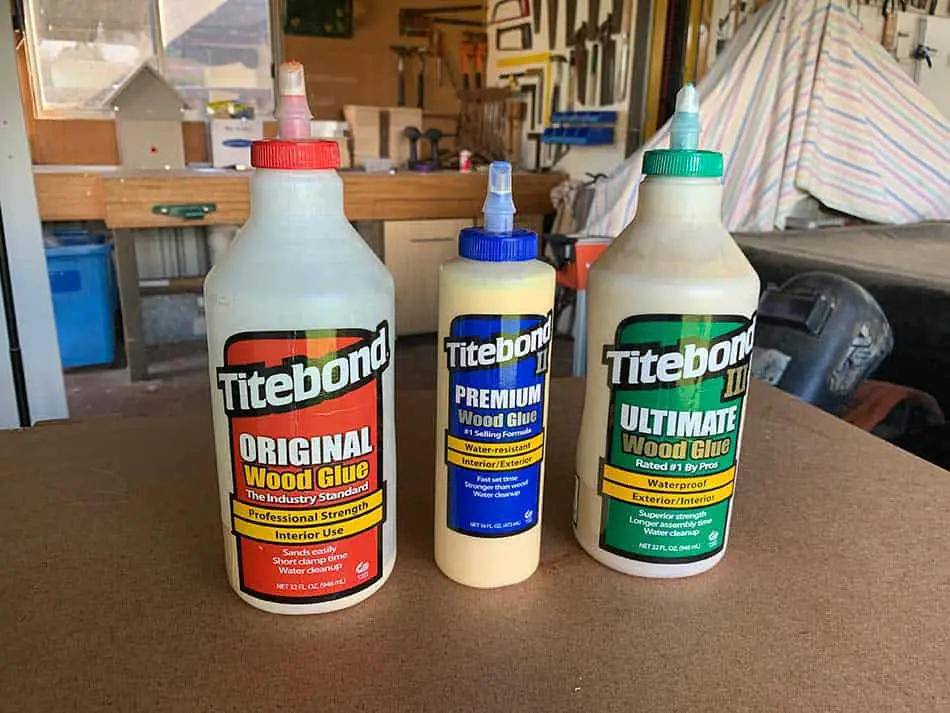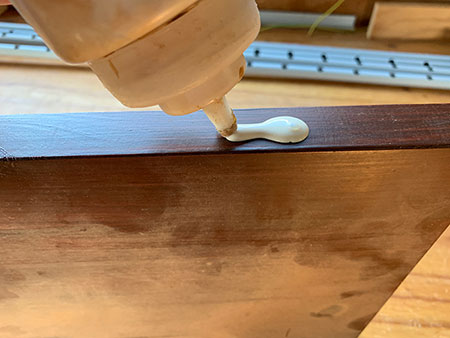Let’s say your latest woodworking project is a tiny box, such as a music box. You want to glue the walls of the box together, and you also plan to stain the box itself.
The thought of fitting a brush into the small crevices of the wooden box after you assemble it makes you think you should stain first. Can you glue wood after staining?
You can glue wood after staining. Wood glue such as Titebond will adhere to stained wood provided the stain has been left to dry for 48 hours. The bond will only be as strong as the bond between the stain and the wood.
Ahead, I will discuss in more detail when you want to stain first and glue later. I also tell you how to do this so your woodworking projects can turn out just the way you want them. Keep reading, as you’re not going to want to miss it!

When Would You Want to Glue Wood After Staining?
If you’re new to the world of woodworking, it’s important to map out your project and all the steps required from start to finish before you begin on anything. This way, you can avoid potentially troublesome quandaries, such as whether you should stain your wood first and then glue or glue it first and then stain.
Gluing the wood first and staining it second does have its upsides, but once the whole wooden item is assembled, sometimes it’s hard to stain all areas.
For example, if you’re building a dresser from scratch, getting into each drawer and the undersides of the dresser to stain these parts is going to prove really difficult. Yet leaving the wood raw can detract from the overall look of your project.
That’s why some woodworkers will stain first and then assemble their project with glue. Here are a few instances in which you may do the same. When gluing and staining, always be sure to wear an apron to save your clothes.
Making a Small Item
This is the example we talked about in the intro. Tiny woodworking projects are some of the most impressive because of the painstaking level of detail reduced to such a small scale.
Yet cramming a full-sized brush into a small wooden item to stain it is going to cause a major headache. It’s much easier to stain the parts of the project before they’re put together and then glue them afterward.
Assembling a Bookshelf
Like with a homemade dresser, a bookshelf has a lot of sides. The shelves themselves feature a top, bottom, and then four sides per shelf. Without staining these beforehand, once you’re done erecting the shelf, you could end up with more raw exposed sides than you realized.
Having raw wood showing on your bookshelf can make the whole thing come across as amateur (unless it’s the look you’re going for), yet staining exposed sides when the bookshelf is already assembled can be challenging. Once again, you have to cram your brush into a tight spot, potentially leaking stains elsewhere.
Creating an Item with Many Corners or Crevices
Are you into wood sculpting? Do you make intricate projects? As you can probably guess by this point, any complex project that boasts a lot of crevices or corners benefits from being stained first, and glued later.
Two-Tone Projects
Some woodworkers prefer creating in a two-tone style. For instance, maybe they find raw wood desirable, or they want some wooden components of their project a lighter color and then other parts a darker color.
Staining one part of the wood project (or even both in two colors) is one way to get this cool two-tone effect.
Does Wood Glue Work On Stained/Painted Wood?
For the most part, as I said in the intro, you can indeed stain first and glue second. However, the glue you use is very important. I did a test which is the photo I took at the top of this page.
I started with basic PVA glue. After the glue had dried, I attempted to peel the glue off. To my surprise, it peeled straight off. I guess the problem was the glue was just ordinary wood glue and the finish was oil with stain. Not what you would normally come across.
You don’t want to choose any old craft glue you have lying around the house, as this isn’t an appropriate pick for the job. Instead, you need wood glue. Even still, you can’t just buy any wood glue that seems decent, like some bond better to stained woods than others.
Here’s a quick lesson on bonding. Adhesive bonding occurs when you connect two surfaces, such as pieces of wood, with glue to create a bond. Some adhesive bonding calls for the adhesive to be applied on both surfaces while others just need one.
The strength of the adhesive bond is what makes the glued parts stay together. If you’ve ever used craft glue for a non-woodworking project and found that the project fell apart within a few days, it’s because the craft glue couldn’t bond to the surface.
Will Titebond Adhere To Stained Wood?

Titebond will adhere to stained wood but the bond will only be as strong as the bond between the wood and the stain.
Titebond is a well-known brand of wood glue, yet all its products should not be applied to the stain. On their website, they said the following: “Most of our glues are designed to bond to bare wood. Painting or staining wood blocks the pores, keeping the glue from penetrating into the wood.”
That said, Titebond does mention that their Polyurethane Glue can attach stained wood surfaces together, but they caution that “it is necessary to remember that the overall bond will only be as strong between the paint and the wood.”
To maximize that bond, Titebond suggests cleaning away any traces of sealer, paint, or leftover stain.
To reiterate then, while you can glue stained wood, you need to really shop around for a suitable wood glue brand. Otherwise, the glue might not create the adhesive bond on the stained wood you need for a lasting project.
Will Gorilla Glue Work On Stained Wood?
Gorilla Glue will adhere to stained wood provided that the stain has not been coated with a sealer, varnish, or any type of shellac. The bond will only be as strong as the bond between the wood and the stain.
One reviewer mentions that the glue dries translucently but may look yellow against the wood stain.
How to Glue Stained Wood
You’ve decided through this article that you want to stain your wood project before gluing it. You found a brand of wood glue that should bond to the stained wood. Now it’s time to get gluing.
Here’s what you need to do.
Step 1: Clear your workstation of any other in-progress projects, wood debris, tools, parts, or anything else remaining.
Step 2: Layout the stained wood pieces you’d like to glue on your clean workstation. Be sure to wear an apron.
Step 3: With some masking tape, cover as much of the stained wood surface as you can. Leave the parts you plan on gluing un-taped.
Step 4: Wearing rubber gloves or some other form of hand protection, uncap your wood glue and apply some on the surface of your stained wood.
Step 5: Glue your stained wood pieces together, applying the glue on one or both sides of the pieces. Try not to use more glue than you need, as it can ooze out and leak.
Step 6: When your stained wood pieces are assembled, allow the glue to dry. You may have to hold the pieces in place for the first couple of minutes until the glue can bond to the wood.
Step 7: Follow the instructions on your wood glue for drying times. When the glue is completely dried and it’s safe to touch your wood project again, gently remove the masking tape from the rest of the stained wood.
Got Glue Marks on Stained Wood? How to Remove Them
Did your glue get stuck when you tried to squirt some out and then way too much came out at once? Perhaps you thought you had applied the right amount of glue, but then when you attached two pieces of wood together, the glue began seeping out.
It happens, especially if you’re a beginner. Discovering wood glue stains on your woodworking project can leave you feeling heartbroken, but there’s often no need to despair. You have a few things you can do to restore the wood to its former glory.
First, attempt to scrape away the glue with a cabinet scraper or a similar tool. Don’t dig into the wood here, as you may damage the wood itself. Go gently yet with some elbow grease to get this done.
Next, use a sanding pad to sand the area, buffing away any last residue of the dried glue. As you can imagine, between scraping and sanding, most of your original stain may be removed. That’s okay, as you want to replace the stain on the affected piece of wood, reapplying it now.
It’s always better to have glue residue on unstained wood over stained wood, as you have less to do to clean up the mess. Even better than that is not having glue residue on your wood project at all, but if you can’t help that, at least you know how to fix it.
Conclusion – Can You Glue Wood After Staining?
Staining your wood before you glue, is recommended when assembling small boxes, dressers, shelving, and any other project with tight crevices. Make sure you read the instructions on your wood glue to ensure the glue can bond to stained wood, as not all wood glue can.
Then, cover up most of the stained wood with masking tape to prevent glue stains from affecting your final project. Always make sure to apply your final finish after it has been glued up. Best of luck!




